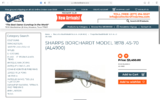WebleyGreene455
AH fanatic
Have a look at this antique Sharps-Borchardt for sale: https://www.collectorsfirearms.com/products/3121-sharps-borchardt-model-1878-45-70-al4900.html
It's not exactly a work of art, that rifle. The Borchardt action isn't quite as elegant to my eye as the '74 Sharps or some of the British falling blocks. The wood may not be terribly high grade, then or now. Overall it's a plain working rifle, not a showcase of a 19th Century custom-gunmaker's skill and attention to detail, really. I couldn't tell you if it was used for hunting or for combat or for both or for neither.
But think about it for a moment. Take a look at the dings and dents on the side of the forearm. I'd be almost certain those came from the rifle resting against a saddle and bumping into the horn/pommel over and over with each step of the horse. How much riding did he have to do for all that denting? What was he riding for? Where was he going? Why'd he need that big long rifle over his saddle? What stories could that gun tell if it could speak? Those dents don't make the rifle any less pretty to me; they just add character to it. One of the coolest things about vintage guns is seeing the dents from a saddle, the marks where the butt of a revolver was used as a hammer for nails or tacks, the knock from where it was used as a club in the heat of battle. Every one has a little bit of that gun's history in it, even the bad ones we may be ashamed of and wish had never happened.
Hunt with your lovely wood, your engraving, your vivid color-case hardening, your fire-blued steel. It's what your gun was made for. Then maybe in another hundred years someone will look at it and say "What stories could that gun tell?" too.
It's not exactly a work of art, that rifle. The Borchardt action isn't quite as elegant to my eye as the '74 Sharps or some of the British falling blocks. The wood may not be terribly high grade, then or now. Overall it's a plain working rifle, not a showcase of a 19th Century custom-gunmaker's skill and attention to detail, really. I couldn't tell you if it was used for hunting or for combat or for both or for neither.
But think about it for a moment. Take a look at the dings and dents on the side of the forearm. I'd be almost certain those came from the rifle resting against a saddle and bumping into the horn/pommel over and over with each step of the horse. How much riding did he have to do for all that denting? What was he riding for? Where was he going? Why'd he need that big long rifle over his saddle? What stories could that gun tell if it could speak? Those dents don't make the rifle any less pretty to me; they just add character to it. One of the coolest things about vintage guns is seeing the dents from a saddle, the marks where the butt of a revolver was used as a hammer for nails or tacks, the knock from where it was used as a club in the heat of battle. Every one has a little bit of that gun's history in it, even the bad ones we may be ashamed of and wish had never happened.
Hunt with your lovely wood, your engraving, your vivid color-case hardening, your fire-blued steel. It's what your gun was made for. Then maybe in another hundred years someone will look at it and say "What stories could that gun tell?" too.


